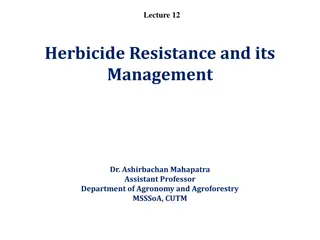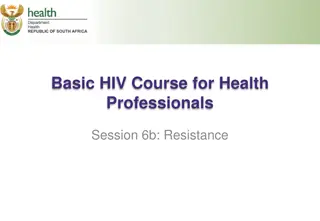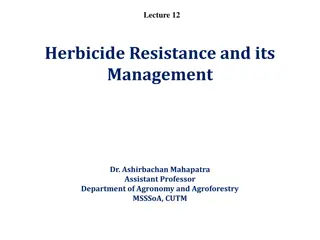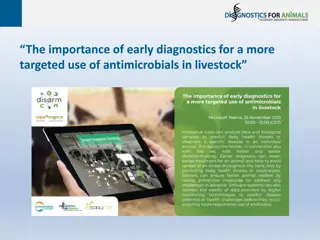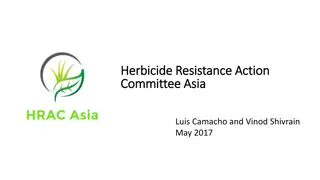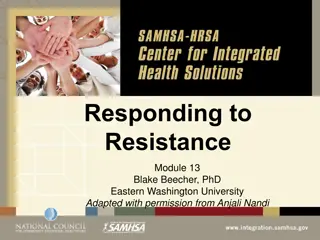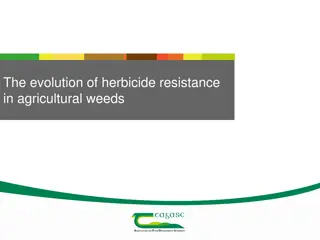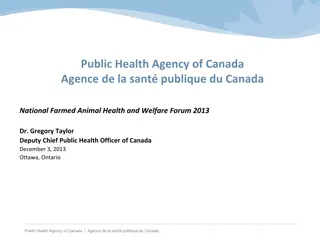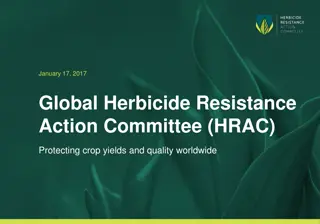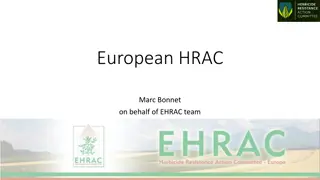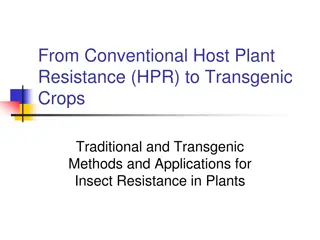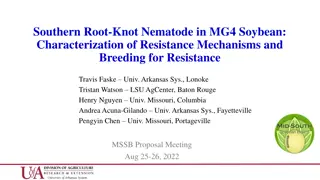Understanding Multidrug Resistance in Bacterial Infections
Multidrug resistance refers to organisms resistant to multiple antibiotics, impacting therapy decisions, increasing morbidity and mortality, and raising healthcare costs. Monitoring resistance profiles can aid in tracking outbreaks, with molecular typing confirming issues. Join the WHONET Webinar Se
0 views • 35 slides
Peptic Ulcer Disease: Treatment Approaches and Helicobacter pylori Eradication
Common gastrointestinal conditions such as peptic ulcers can be effectively treated through approaches like eradicating H. pylori infection, reducing gastric acid secretion, and using mucosal protecting agents. Helicobacter pylori eradication is crucial for healing ulcers and preventing recurrence,
0 views • 27 slides
Understanding the Natural History of Disease Development and Prevention
The natural history of disease development outlines the progression of a disease in an individual without intervention, from exposure to outcome. Learning objectives include defining prevention terms, understanding disease severity, prevention levels, and intervention measures. Studying disease prog
4 views • 16 slides
Understanding Herbicide Resistance and Management
Herbicide resistance is the inheritable ability of certain weed populations to survive herbicide treatments that would typically control them. This resistance is a natural process, influenced by factors like genetic diversity, herbicide selection pressure, and resistance mechanisms. Effective manage
12 views • 14 slides
Trends in Gonococcal Resistance to Therapies in England and Wales Since 2011 Guideline Change
Antimicrobial resistance in Neisseria gonorrhoeae poses challenges for treatment. This study examines trends in ceftriaxone, azithromycin, and cefixime resistance since the 2011 guideline change in the UK. Data from the Gonococcal Resistance to Antimicrobial Surveillance Programme is analyzed to tra
0 views • 12 slides
Principles of Epidemiology: Understanding Disease Occurrence and Surveillance
Epidemiology is the study of disease patterns, factors influencing disease occurrence, and the core functions of surveillance, field investigation, and analytic studies. It involves understanding disease characteristics, natural history, and evaluating the effectiveness of activities to mitigate dis
1 views • 25 slides
Understanding Forces: Gravity, Air Resistance, and Parachutes
Explore the concepts of gravity, air resistance, weight versus mass, and how they relate to objects in motion. Discover how Sir Isaac Newton's discoveries shaped our understanding of forces, and learn how air resistance affects the speed of falling objects. Delve into the mechanics of parachutes and
0 views • 9 slides
Understanding Ohm's Law and Electrical Resistance
Explore the principles of Ohm's Law and electrical resistance, understanding how resistance affects electron flow in circuits, the relationship between voltage drop and resistance, and practical examples of applying Ohm's Law in circuit calculations. Discover the impact of resistance in wires and ho
0 views • 19 slides
Understanding Wheatstone Bridge Circuit for Resistance Measurement
Wheatstone Bridge is a precise instrument for measuring unknown electrical resistances by balancing a bridge circuit. This practical application involves using resistors of known values to determine the unknown resistance. The voltage division formula plays a key role in calculating the unknown resi
0 views • 9 slides
Understanding Water Resistance in Everyday Life
Water resistance is a type of friction experienced when objects move through water, similar to air resistance. This force slows down objects moving through water, like when swimming. Animals and humans adapt by using streamlined designs to reduce water resistance. Experimenting with different shaped
1 views • 11 slides
Insights into Tyzzer's Disease: An Overview of a Bacterial Infection in Laboratory Animals
Tyzzer's disease is an acute bacterial infection affecting rodents and rabbits, caused by Clostridium piliforme. Discovered in 1917 by Ernest Tyzzer, the disease is characterized by necrotic lesions in the caecal mucosa, liver, and heart. Initially known as Bacillus piliformis, it was later renamed
2 views • 21 slides
Understanding HIV Drug Resistance in Health Professionals
Combination antiretroviral therapy (ART) is effective against HIV but can lead to drug resistance if not taken consistently. HIV mutates rapidly, increasing the risk of drug-resistant strains emerging. Learn about the causes, types of resistance, testing methods, and prevention strategies to combat
0 views • 23 slides
Strategies to Overcome Resistance to Change in Organizations
Overcoming resistance to change is crucial in change management projects. This process involves planning for, identifying, and managing various forms of resistance. Understanding why people resist change and utilizing strategies such as seeking feedback, effective communication, and proactive manage
0 views • 11 slides
Understanding Disease Control and Prevention in Epidemiology
This article discusses disease control processes in epidemiology, including reducing disease incidence, duration, and transmission. It covers public policy interventions, elimination, eradication, and extinction of infectious agents. It also highlights preventable causes of disease and different lev
2 views • 10 slides
Understanding Herbicide Resistance in Weeds: Insights and Management Strategies
Herbicide resistance is a naturally occurring phenomenon in weed populations, impacting the effectiveness of herbicide treatments. This resistance can be passed down through generations and is influenced by various factors such as cultural practices, herbicide mechanisms, and the biology of weed spe
0 views • 14 slides
Enhancing Livestock Health Through Early Diagnostics and Targeted Antimicrobial Use
Utilizing early diagnostics in livestock for targeted antimicrobial administration is essential for effective disease management and reducing antimicrobial resistance. This approach aids in timely treatment, facilitates monitoring of animal health status, and supports preventive measures against eme
0 views • 10 slides
Screening for Peripheral Vascular Disease in Patients with Coronary Artery Disease
Patients with coronary artery disease should be screened for peripheral vascular disease as it is a frequent integrator of global cardiovascular risk. The association of atherosclerosis in various arterial diseases highlights the importance of identifying multisite artery disease. The prevalence and
0 views • 23 slides
Understanding Antibiotic Resistance in Recycled Wastewater
Explore the potential connection between recycled municipal wastewater and antibiotic resistance. Antibiotic-resistant bacteria pose a serious threat, fueled by factors like horizontal gene transfer and high antibiotic dosages in clinical settings. Environmental antibiotic resistance, linked to agri
4 views • 46 slides
Understanding Electric Circuits: Current, Voltage, and Resistance
Electric circuits involve the flow of electric current through conductors with varying levels of resistance. Current (I) is the amount of charge passing through a point in a wire per unit of time, measured in amperes. Voltage (V) is the potential difference required to make electrons flow in a condu
0 views • 25 slides
Human Disease Symptom Network: Understanding Disease Relationships Through Symptoms and Genes
The Human Disease Symptom Network (HSDN) is constructed using a large-scale medical bibliographic records database to form a network of human diseases based on symptom similarities. By integrating disease-gene associations and protein-protein interaction data, correlations between symptom similarity
0 views • 37 slides
Challenges and Trends in Herbicide Resistance Management in Asia-Pacific Region
The Asia-Pacific region faces challenges with herbicide resistance, particularly in countries like China and Australia. Issues include incorrect herbicide application, resistance cases reported, and concerns about glyphosate resistance. Additionally, the introduction of herbicide-tolerant traits in
0 views • 11 slides
Dealing with Resistance in Counseling: Techniques and Strategies
Understanding resistance in counseling is crucial for effective communication and rapport building. This module explores various forms of resistance, counselor behaviors that elicit resistance, and ways to diminish resistance. Learning to respond differently to resistance can lead to valuable feedba
0 views • 27 slides
Understanding Bacterial Diseases of Fish: Columnaris Disease Overview
Columnaris disease, also known as Saddleback disease, is a common bacterial infection in fish that is often brought about by poor handling and high stress levels. This disease manifests as tail and fin rot, leading to rapid fish mortality. The causative organism, Cytophaga (formerly Flexibacter), is
0 views • 21 slides
Understanding Herbicide Resistance in Agricultural Weeds
This comprehensive content covers the evolution of herbicide resistance in agricultural weeds, including the origins of herbicides, cases of resistance, target site resistance, and non-target site resistance. It explains the definition of weeds, types of herbicides, selective and non-selective herbi
0 views • 32 slides
Challenges in Conducting Interventional Trials for Antibacterial Resistance
Addressing antibacterial resistance through interventional trials presents challenges relating to nomenclature, trial design implications, and the continuous evolution of resistant bacteria categories. The discussion emphasizes the need for a sustained pipeline of novel therapies to combat resistanc
0 views • 39 slides
Effective Strategies for Addressing Resistance in Motivational Interviewing Sessions
Explore the key concepts of team functioning and motivational interviewing, learn to intervene with clients effectively, and understand resistance as a barrier to change. Discover strategies to address resistance, identify different types of resistance, and learn to navigate through various expressi
0 views • 27 slides
Understanding Electric Currents and Resistance II in Physics
Capacitors, resistance, energy usage, and the microscopic picture of conductivity are explored in this lecture on electric currents and resistance II in Physics 2415. Discover the relationship between voltage, charge, current, and resistance, along with insights into power usage, resistivity, and th
0 views • 22 slides
Understanding Power Consumption and Resistance in Marine Engineering
Learn about hull resistance, factors affecting resistances and power consumption, propulsion chain efficiency, and power consumption of auxiliary equipment and hotel load in marine engineering. Explore different types of resistance such as frictional, residual, eddy, wave, and air resistance, along
0 views • 15 slides
Understanding Voltage, Current, Resistance, and Ohm's Law
Learn the fundamentals of voltage, current, resistance, and power, along with insights into Ohm’s Law. Discover how these concepts are interconnected and essential for understanding electrical circuits. Explore the unit of voltage, the movement of electrical current, the concept of resistance, and
0 views • 5 slides
In Vitro Selection of Enterobacter cloacae Resistance Mechanisms with Antibiotics
Study by Mariana Castanheira et al. presented at IDWeek 2020 discusses the generation of diverse resistance mechanisms in Enterobacter cloacae with cefepime, meropenem, and ceftazidime-avibactam. E. cloacae, a significant pathogen causing human infections, exhibits various resistance mechanisms, inc
0 views • 21 slides
Complexities of Antimicrobial Resistance in Farm Animals and Public Health
The epidemiology of antimicrobial resistance is multifaceted, involving various sectors such as aquaculture, soil, wildlife, human-animal interfaces, and more. The case study on ceftiofur resistance in chickens highlights the impact of antibiotic use on resistance levels in both animals and humans.
0 views • 4 slides
Global Herbicide Resistance Action Committee (HRAC): Protecting Crop Yields Worldwide
The Global Herbicide Resistance Action Committee (HRAC) is a global leader in managing herbicide resistance to safeguard crop yields and quality. They focus on collecting, assessing, and providing vital information to combat herbicide resistance. Their mission is to support industry experts working
0 views • 12 slides
United States Herbicide Resistance Action Committee Summary
Herbicide resistance is a critical issue being tackled by the United States Herbicide Resistance Action Committee (US HRAC). Formed in 2015, US HRAC operates independently from Global HRAC, focusing on specific areas while aligning on key herbicide resistance matters. The committee engages in variou
0 views • 6 slides
Understanding the Relationship between Decisional Second-Preimage Resistance and Preimage Resistance in Cryptographic Hash Functions
This work delves into the subtle question of when Decisional Second-Preimage Resistance (SPR) implies Preimage Resistance (PRE) in hash functions. It presents a tool for enabling tight security proofs for hash-based signatures by exploring the success probability of adversaries against collision res
0 views • 25 slides
Recent Advances in FEVE Fluoropolymer Resin Technology
Recent discoveries in FEVE technology showcase the impressive properties of Fluoroethylene Vinyl Ether (FEVE) resins, such as weatherability, chemical resistance, gloss, solubility, and crosslinking. These resins offer ambient cure for field applications, OH functionality for crosslinking, solvent s
0 views • 25 slides
European HRAC - Herbicide Resistance Action Committee
European HRAC, led by Marc Bonnet, is a group of industry experts working on herbicide resistance issues. The team includes members from various companies and focuses on leveraging their collective knowledge to address resistance challenges. Their SWOT analysis highlights strengths, weaknesses, oppo
0 views • 7 slides
New Horizon for Overcoming Hormonal Treatment Resistance in Metastatic Breast Cancer Patients
Breast cancer, particularly estrogen receptor-positive tumors, poses a significant challenge due to endocrine resistance. While endocrine therapy is effective, resistance can occur in both early and advanced stages of the disease. This presentation discusses novel approaches to address this resistan
0 views • 21 slides
Evolution of Plant Resistance to Insects: From Traditional Methods to Transgenic Crops
The transition from Conventional Host Plant Resistance (HPR) to Transgenic Crops for insect resistance in plants has a rich history dating back to the 1790s. Traditional methods like breeding for Hessian fly resistance in wheat have paved the way for modern techniques. Factors influencing insect res
0 views • 36 slides
Characterization of Resistance Mechanisms in MG4 Soybean against Southern Root-Knot Nematode
This study focuses on understanding the resistance mechanisms in MG4 soybean against the Southern Root-Knot Nematode (Meloidogyne incognita) and breeding for resistant varieties. Researchers are characterizing resistance, developing new markers, and creating varieties with enhanced resistance. Field
0 views • 9 slides
Impact of Resistance on Parasite Fitness in Quinoline-based Antimalarial Drugs
Resistance cost of fitness studies the impact of drug resistance on pathogens like Plasmodium berghei. Lumefantrine and Piperaquine, used in ACT against malaria, are investigated to understand how resistance affects parasite fitness. The research aims to provide insights into combating drug resistan
0 views • 15 slides



